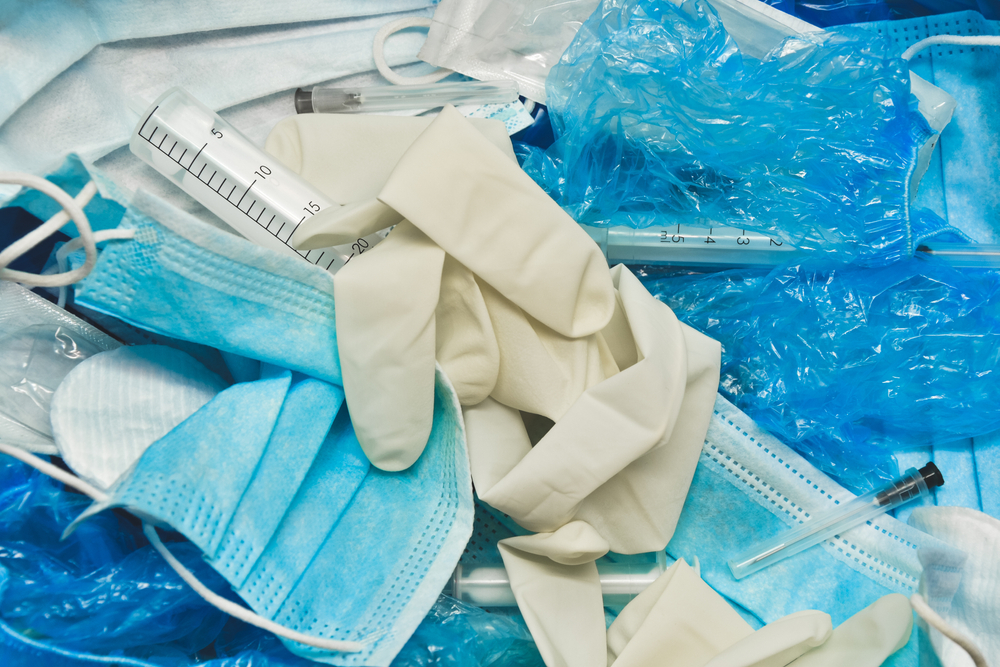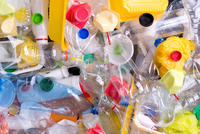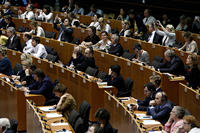
@ ADELART/Shutterstock
In Europe, the period 2020-2021 was to mark the turning point in the fight against plastic waste, one of the most urgent problems of our century. Then came the new Coronavirus: with masks, gloves, and anti-contagion packaging, the risk of a step back is increasingly concrete
Lowered on the chin or worn correctly, generously distributed in schools and workplaces, sold everywhere at a controlled price, face masks are now a constant presence in the lives of billions of people. A gust of wind or a distraction is enough for them to disperse in the environment, and already in the first months of the pandemic, when for many they were still unavailable, they had become fairly common waste on the beaches of all oceans.
But protective gear – not just masks, but also gloves, aprons, visors – are just one of the factors that have led plastic consumption to skyrocket in times of pandemic.
In addition to the use of light packaging, between online shopping and hygiene precautions, hospital waste is also increasing. Meanwhile, the months of lockdown have hit the recycling supply chain hard and the collapse in the price of the oil needed to produce new plastics has done the rest.
2021 should have been the turning point for Europe. In July, the now famous directive restricting single-use plastics will come into effect as part of an ambitious transition strategy towards a circular economy. Instead, it was the year in which humanity realised its dangerous addiction to plastics, especially disposable ones.
Masks, everywhere
Nobody knows exactly how many personal protective devices have been used since the arrival of Covid-19. Just think that the turnover that revolves around face masks has multiplied by about 200 times, passing from 800 million to 166 billion dollars in one year .
A few months ago, scholars estimated that in 2020 something like 129 billion masks would be used globally every month, to be added to other protective devices (gloves, visors, aprons) that travel on lower, but still impressive figures. The persistence of the emergency and the extension to more and more countries of the obligation to wear masks have made this estimate even optimistic: more recent studies speak of 7 billion devices a day globally, 210 billion every month. The European continent, as a whole, therefore consumes about one billion a day. In terms of weight (a mask weighs about 3 grams), in the European Union alone, around 1600 tons of masks end up in the waste every day.
According to this order of magnitude, we can estimate the weight of the masks used annually in the Union at about half a million tons: a figure that corresponds to about 8% of the plastic that ended up in landfills in recent years (7.25 million tons in 2018). If all the masks ended up in landfills (in fact, a good part is incinerated) they would be enough, alone, to bring us back to the levels of about 10 years ago.
Paradoxically, face masks are made largely of polypropylene, a recyclable material, but to avoid the risk of contagion they cannot enter the separate waste collection chain.
Furthermore, given their lightness and diffusion, it is inevitable that some of the protective devices end up dispersing into the environment, leading to a health and environmental risk. According to a WWF report released during the first wave, if even just 1% of the masks were accidentally dispersed in the environment, it would mean ten million tons per month in meadows, woods, streams, and seas. In fact, the estimates for littering, that is the fraction of waste dispersed, speak of 2% in the countries of the global North . In the European Union alone, we are therefore talking between 16 and 32 tonnes a day.
Already in the first months of 2020, finding masks carried by currents had become common in many Pacific beaches. Since then, the quantity has only increased. They generally tend to float, but heavier ones sink or remain suspended at all depths. Scientists have already observed sharks, turtles, marine mammals, and birds that have ingested them whole, while many other organisms are often victims of the elastic cords used to secure them to the face. Destined, like all plastics that end up in the sea, to fragment into microplastics (particularly microfibers), they could end up permeating the food chain at every level and soon become, according to some scientists , the number one source of garbage debris in the oceans. Some will end up in marine sediments, perhaps leaving a testimony of the pandemic for the next geological eras.
The new packaging boom
For years, packaging has been the most voluminous fraction of plastic waste, and in the European Union it absorbs as much as 40% of all plastic demand. This category of waste, despite the numerous initiatives to limit it, has grown inexorably in recent years. Plastic used in packaging (of which it is the second constituent material after paper and cardboard), after the shutdown due to the economic crisis of 2008, grew by an average of 2% per year, exceeding 14 million tons in 2019.
Now, following the pandemic, packaging will further accelerate its run. Years of raising awareness against excessive packaging, especially in the food sector, have done nothing in the face of virus fear. And of all the possible materials plastic, perceived (more wrongly than rightly) as more "aseptic" and hygienic, was the favourite solution.
The most significant growth, however, will probably be due to the incredible leap forward of online commerce. In the second quarter of 2020, writes the Vox newspaper, digital sales increased by 71%, and by 55% in the third.
The annual growth rate of the packaging sector, according to the consultancy firm Markets and Markets, will stand at 5.5% globally, that is over 100 billion dollars more than in 2019. No surprise, hygienic and sanitary packaging and online shopping will drive the growth. It is difficult to say how much waste will be produced, but it is safe to bet that these will not be negligible figures.
The explosion of medical waste
As can be easily imagined, health sector waste has increased dramatically since the outbreak of the pandemic. In addition to hospital waste, domestic waste produced by people in quarantine contributes to inflate the figures. In Wuhan, in the first months of 2020, they grew six times compared to the previous year. European countries also saw a comparable increase in the following weeks. According to the aforementioned study, 70,000 tons of sanitary waste are currently produced throughout the European continent. For the European Union alone, with this order of magnitude, we get about 40,000 tons, six or seven times more than in pre-pandemic times.
Concentrated in certain facilities and disposed of or incinerated under controlled conditions, despite the impressive increase this waste seems to be under control, at least in Europe. The same cannot be said of many countries in the southern hemisphere which already had difficulties in disposing of waste. In many cases, the large amount of medical waste has led to its disposal in open landfills, with risks to public health and serious environmental consequences.
Recycling in crisis
While demand for plastics skyrocketed during the toughest months of the lockdown, much of the complex waste processing machine was practically at a standstill. On the other hand, the price of oil dropped to historic lows, making it extraordinarily profitable to produce virgin plastic. The situation for the recycling supply chain in Europe appeared so bad that Tom Emans, president of the Plastics Recyclers Europe industry association, said that without action at EU level the entire EU recycling industry was in danger of shutting down.
According to a Reuters survey, global demand for recycled plastics fell by over 20% in the first half of 2020.
Pending the complete data on the entire period, we can get an idea of the impact of the pandemic by looking at the data provided in the Italy report of the Recycling of the Unione Imprese Economia Circolare. Between March and May 2020, the document reads, 53% of companies and consortia involved in the waste supply chain reported reductions in separate collection by over 20%. Between May and August, the still marked decline was around -10%.
Fortunately, this aspect of the crisis turned out to be temporary, and the numbers returned to normal in the second half of the year.
Giving Covid the right weight
Despite the staggering numbers, it is still early to say whether in absolute terms pandemic-related plastics will really impact plastics trends in the long term. The last decade has been characterised by major efforts in at least 127 countries around the world, including regulations, bans, and public awareness initiatives. These initiatives are significantly reducing the percentage of plastic destined for landfill or, worse still, for direct dispersion into the environment. Nonetheless, polymer production is increasing so rapidly that in absolute terms the numbers continue to grow, and by a lot. And plastic stays around for decades.
At this rate, it is estimated that by 2050 99% of seabird species will have ingested plastic, allowing it to enter all ecosystems on the planet.
The European Union, which has adopted an ambitious strategy for a transition to a circular economy, is perhaps the political entity that has done the most to solve the plastics problem. Despite the overall increase in waste produced, between 2006 and 2018 the percentage of plastic used by citizens that ends up in landfills dropped by 44%, from 12.9 to 7.25 million tons. Part of this success, however, has been achieved thanks to the export of recyclable material to other countries, where the same standards are not always guaranteed. China, once the largest buyer of waste, closed its doors in 2017, and many other countries could follow suit. In addition to the ethical aspect, there is an amendment to the Basel Convention on waste which, since January of this year, makes the criteria for exports much more demanding. It is likely that this will significantly reduce the successes flaunted so far, and for this reason it is necessary to work even more urgently.
The legacy of the pandemic
Beyond the figures, the plastic from Covid-19 has made it clear that we are at a crossroads. On the one hand, pressures to reduce or dismantle anti-plastic regulations have multiplied during the emergency. In many cases the attempts have been successful. The Disposable Plastics Directive also initially risked being postponed or heavily watered down, but ultimately remained standing.
On the other hand, however, many think that the Covid-19 experience can teach us to change pace. According to a study published in Science of the Total Environment , the pandemic should push us to apply plastic containment strategies with even more conviction. Efforts, however, should concern the sector in all its phases, starting from design. New products should be designed from the start to facilitate recycling and reuse. Plastics not directly derived from fossil fuels could be encouraged through research on bioplastics, which is not a real option at the moment. Masks, gloves, and visors could also be made with these materials.
It is now clear that strategies for managing the waste cycle must become more flexible and be able to cope with unforeseen events on a global scale (not necessarily a pandemic).
Public awareness, researchers argue unanimously, is another fundamental aspect. However, there is often a tendency to place on consumers all the responsibilities that industry and politics do not want to take on. If it is true that the polymer industry is investing more than in the past in recycled plastic, in fact, it continues to invest much more in virgin plastic, thanks to the ever-increasing demand.
"Consumers should prefer sustainable alternatives, and at the same time these must be sufficiently available, which is up to industries and can be promoted or imposed by governments", explains researcher Joana C. Prata of the Center for Environmental and Marine Studies of the University of Aveiro, Portugal.
An event such as a pandemic has a lot to tell us in a world where changes are becoming ever faster and sweeping the entire planet in a short time. If we are able to listen.
Strategia europea per la plastica
In 2018 the European Commission presented the European strategy for plastics. The measures in the strategy included the improvement of the supply chain and the value chain of recycled plastics, the reduction of waste, especially at sea, and of single-use plastics, support for global and multilateral initiatives on plastics. The strategy set the goal of ensuring that by 2030 all plastic packaging would be recycled or reusable in the EU. In September 2018, the EU Parliament promoted the strategy by calling for the introduction of minimum requirements for recycled plastics to be included in European products, stringent quality standards, and legal requirements to reduce microplastics.
Interventi recenti del PE
The action is co-financed by the European Union in the frame of the European Parliament (EP)'s grant programme in the field of communication. The EP is, in no case, responsible for or bound by the information or opinions expressed in the context of this action. The contents are the sole responsibility of OBC Transeuropa and can in no way be taken to reflect the views of the European Union. Go to the project’s page: “The Parliament of rights 3”.









 To Top
To Top